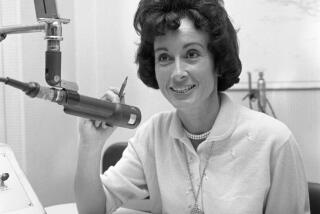Richard Taylor, Stanford physicist who won Nobel Prize for discovering quarks, dies at 88
- Share via
Shortly after learning he’d won the Nobel Prize in physics, Richard Taylor stared at his reflection in a mirror.
“Murray Gell-Mann is smart. Dick Garwin is smart,” he told himself, referring to two pioneering 20th-century physicists. “You are lucky.”
The self-effacing Taylor, a Stanford University professor emeritus of physics who shared the Nobel in 1990 for his role in the discovery of quarks, died at his home on the Stanford campus last month. He was 88.
Taylor’s experiments with the university-operated SLAC National Accelerator Laboratory in its early days revealed the existence of quarks, the elusive building blocks of the proton, neutron and other subatomic particles.
The discovery set the foundations for the Standard Model, which describes the elementary particles and forces that govern our existence.
Taylor, a strict experimentalist, never saw himself as the discoverer of quarks.
“My job was to measure things and make sure that the measurements that I made were right,” he told an interviewer for the Nobel Prize website in 2008. “It’s the job of the theoretical community to understand why things are the way I see them when I do the experiments. So I was not running around saying, ‘I have discovered quarks.’”
Richard Edward Taylor was born Nov. 2, 1929, in Medicine Hat, Alberta, Canada, to a Scottish American mother and Northern Irish father. World War II radically transformed the small town, as the British Royal Air Force set up camp to train soldiers and later housed German and other Axis prisoners of war there.
Scientists arrived in Medicine Hat ready to work on chemical and biological weapons. They brought with them a completely different culture, Taylor said — one that fed his already-growing love for science.
“The wartime glamour of the military, the sudden infusion of groups of sophisticated and highly-educated people, and new cultural opportunities (the first live symphonic music I ever heard was played by German prisoners of war) all transformed our town and widened the horizons of the young people there,” Taylor wrote.
As a child he sought out science books; in high school he blew three fingers off his left hand when a chemistry experiment at home went explosively wrong. (He’d wanted to go into surgery, he told an interviewer for the Nobel Prize website, but a friend informed him that no one would want a surgeon with missing fingers.)
By his own account, Taylor was not a good student — he failed Latin and never graduated from high school — but he had a gift for physics. He enrolled at the University of Alberta, completing his master’s degree there before heading to Stanford to pursue a Ph.D. in 1952.
He soon started working on accelerators at the university’s High-Energy Physics Lab, and delayed his thesis for a few years to help build an accelerator in France. After less than a year at the Lawrence Berkeley Laboratory, he returned to Stanford in 1962 to work at the nascent Stanford Linear Accelerator Center (or SLAC for short) and complete his dissertation.
Scientists who had been smashing subatomic particles together had already discovered a menagerie of what were called hadrons, a class that includes protons and neutrons as well as more exotic particles, said SLAC experimental physicist Martin Breidenbach, who participated in the experiments as a graduate student at MIT.
“There was this great particle zoo of mesons and other hadrons which people didn’t understand,” he said, ticking off a few: pions, kaons, excited nucleons.
Physicists wanted to know what these hadrons — particularly the buildings blocks of the atom’s nucleus, the proton and neutron — were made of. Was the proton a fundamental particle, with no smaller fragments within it? Or did it have some infinitesimal inner structure?
To find out, SLAC physicists used an accelerator that shot a beam of high-energy electrons at a target of protons and neutrons. Then they studied the subatomic shrapnel that resulted from these collisions. (The two-mile-long accelerator, which cost $114 million, was the longest linear accelerator ever built when it began operating in 1966.)
At the time, many other accelerators were shooting beams of protons at targets. But scientists at SLAC shot beams of electrons instead, hoping that the smaller, simpler particles would provide a cleaner result. Taylor was instrumental in building the beam switchyard, which allowed multiple experiments to run at the same time, as well as its giant spectrometer.
The experiment that earned Taylor and his MIT-based colleagues Jerome I. Friedman and Henry W. Kendall the Nobel Prize was not expected to produce scientific fireworks: Scientists had already shot electrons at lower energies and not found anything unusual.
But to the trio’s surprise, these higher-energy electron beams scattered at wide angles once they hit their target. This told them there was something hard and discrete at the center of the proton. And that meant the proton was not a fundamental, indivisible unit of matter.
Those tiny components were soon identified as quarks, whose existence had been predicted by Caltech physicist Murray Gell-Mann. Later discoveries revealed that they came in six flavors, and different combinations of these flavors could explain the behavior of protons and neutrons as well as the more exotic hadrons that scientists had been discovering.
The discovery of quarks led scientists to develop the Standard Model, “which simplified everything,” Breidenbach said.
“With the beginning of the Standard Model, all of these particles were understandable as collections of two or three quarks,” he added.
On the day the Nobel Prize was announced, Taylor thanked about 30 people and said, “I’m here because I’m probably the oldest and loudest of the group,” according to a Stanford University remembrance.
Taylor was indeed quick to share credit. He insisted that all of the people who worked on the experiment come to Stockholm for the Nobel Prize ceremony, Breidenbach recalled. A photo of the entire group in Norway, dressed in white ties and tails, sat for years on his desk.
Leaders often have the option to delegate less appealing work. Not Taylor, said Les Cottrell, SLAC’s manager of computer networking, who started working with Taylor in 1967.
During active experiments, Taylor regularly took the unpopular early-morning shifts when the machinery had to be monitored around the clock, relieving junior members of the team from that burden. He also stayed late to keep the lab’s director abreast of developments.
“He was very much a person who led from the front,” Cottrell said.
And at the end of these projects, he and his wife would throw large parties for the staff at their house with a pool — not just for the scientists, but also the programmers, engineers and others involved in the experiment’s infrastructure, Cottrell recalled.
A consummate team player, Taylor felt that for experiments such as his, the Nobel Prize should be awarded to groups rather than one to three individuals.
“It’ll acknowledge that it’s not the work of an individual person but a huge group of people,” he said in 2008. “There’s no way to do it fairly with three.”
Taylor passed away on Feb. 22. He is survived by his wife, Rita, and their son, Ted.
Follow @aminawrite on Twitter for more science news and “like” Los Angeles Times Science & Health on Facebook.
MORE IN SCIENCE
Scientists are baffled by mysterious galaxy that seems to be missing its dark matter
By going vegan, America could feed an additional 390 million people, study suggests







